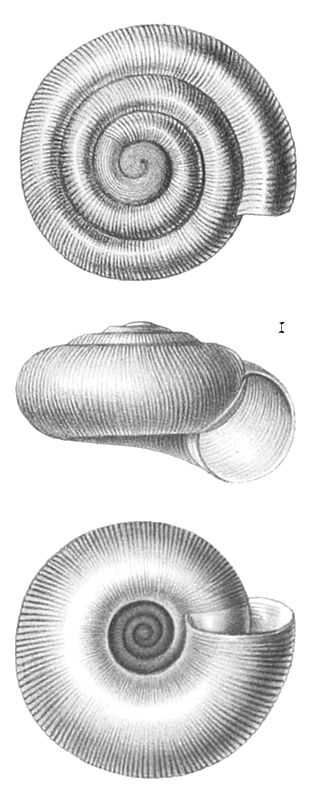
Schizoglossa novoseelandica is a predatory species of air-breathing land slug or semi-slug, a terrestrial gastropod mollusc in the family Rhytididae. It is the type species of the genus Schizoglossa and is found only in New Zealand. The survival of this species is not threatened; it is not listed in the 2009 IUCN Red List nor is it in the 2005 New Zealand Threat Classification System lists.

Achatinella byronii is a species of air-breathing land snail, a terrestrial pulmonate gastropod mollusk in the family Achatinellidae. This species is endemic to Oahu, in the Hawaiian Islands.
Ogasawarana ogasawarana is a species of land snail with an operculum, a terrestrial gastropod mollusk in the family Helicinidae, the helicinids.

Partula mooreana, common name the Moorean viviparous tree snail, is a species of air-breathing tropical land snail, a terrestrial pulmonate gastropod mollusk in the family Partulidae. This species was endemic to French Polynesia. It is now extinct in the wild.
Sinployea canalis was a species of small air-breathing land snail, a terrestrial pulmonate gastropod mollusk in the family Charopidae. This species was endemic to the Cook Islands; it is now extinct.

Sinployea is a genus of small air-breathing land snails, terrestrial pulmonate gastropod mollusks in the family Charopidae.
Sinployea otareae was a species of small air-breathing land snail, a terrestrial pulmonate gastropod mollusc in the family Charopidae. This species was endemic to the Cook Islands; it is now extinct.
Sinployea planospira was a species of small air-breathing land snail, a terrestrial pulmonate gastropod mollusk in the family Charopidae. This species was endemic to the Cook Islands; it is now extinct.
Sinployea proxima was a species of small air-breathing land snail, a terrestrial pulmonate gastropod mollusc in the family Charopidae. This species was endemic to the Cook Islands and it is now extinct.
Sinployea rudis was a species of small air-breathing land snail, a terrestrial pulmonate gastropod mollusc in the family Charopidae. This species was endemic to the Cook Islands; it is now extinct.
Sinployea tenuicostata was a species of small air-breathing land snail, a terrestrial pulmonate gastropod mollusk in the family Charopidae. This species was endemic to the Cook Islands, but has not been found since 1899 and is believed to be extinct.
Sinployea youngi was a species of small air-breathing land snail, a terrestrial pulmonate gastropod mollusc in the family Charopidae. This species was endemic to the Cook Islands; it is now extinct.

Radiodiscus patagonicus is a minute species of air-breathing land snail, a terrestrial gastropod mollusk or micromollusk in the family Charopidae.

Libera is a genus of air-breathing land snails, terrestrial pulmonate gastropod mollusks in the family Endodontidae.

Vexillum exquisitum is a species of small sea snail, marine gastropod mollusk in the family Costellariidae, the ribbed miters.

Notodiscus hookeri is a species of small air-breathing land snail, a terrestrial gastropod mollusk in the family Charopidae. This snail lives on islands in the sub-Antarctic region. Its shell is unique among land snails in that the organic shell layers contain no chitin.
Ba humbugi is the only species and therefore the type species in the genus Ba, a genus of land snail, belonging to the family Charopidae. Both the genus and the species were named by the American malacologist Alan Solem. The genus is endemic to the Fijian island of Viti Levu, and B. humbugi is an endangered species.
Vatusila is a genus of land snail found in Oceania. It consists of five extant and one fossil species. Alan Solem described and named the genus in 1983.

Alvania crystallina is a species of minute sea snail, a marine gastropod mollusk or micromollusk in the family Rissoidae.










